Wondering what to see at the National Gallery of Art in London? Here’s my guide to 20 must see paintings. I also give you tips for visiting this exceeding busy and popular museum, which deserves all its accolades.
The National Gallery houses one of the richest and best collections of paintings in the world. The collection is incredibly diverse, featuring 2,000 European paintings from the 13th to the 19th centuries.
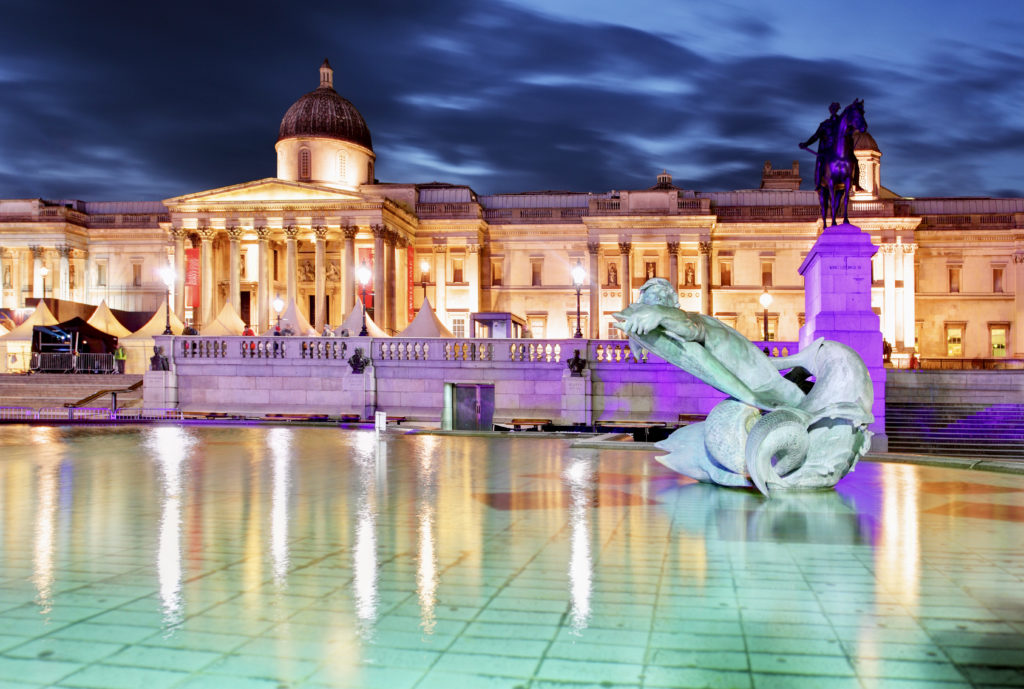
Overview Of The National Gallery In London
The National Gallery is located on the north side of London’s iconic Trafalgar Square. The museum was founded in 1824.
Unlike other world class museums like the Uffizi Gallery, the Louvre, or the Prado, the nucleus of the National Gallery didn’t come from a royal or princely collection. It was founded with several bequests and simply grew organically from gifts and acquisitions.
The National Gallery has the best collection of Italian Renaissance works outside Italy.
READ: Guide To The Best Art In Italy
There are also impressive holdings of works by various British, Dutch, French, Spanish, and Flemish painters. You’ll find works by renowned artists like Rembrandt, Leonardo da Vinci, Michelangelo, Botticelli, J.M.W. Turner, Monet, and Van Gogh.
The paintings are displayed in chronological order in four wings on the main floor. The wings are:
- Sainsbury Wing (1250-1500: Medieval and Early Renaissance)
- West Wing (1500-1600: High Renaissance)
- North Wing (1600-1700: Baroque Era)
- East Wing (1700-early 20th century: Romanticism, Realism, Impressionism)
The gallery is an artistic experience in and of itself. It has soaring ceilings and glass topped domes. The floor of the entryway is covered with beautiful mosaics depicting the Labors of Life, the Pleasures of Life, and Modern Virtues.
Guide To London’s National Gallery: What To See
There are so many masterpieces at the National Gallery. But here are 20 famous paintings that every art lover should see, in chronological order.
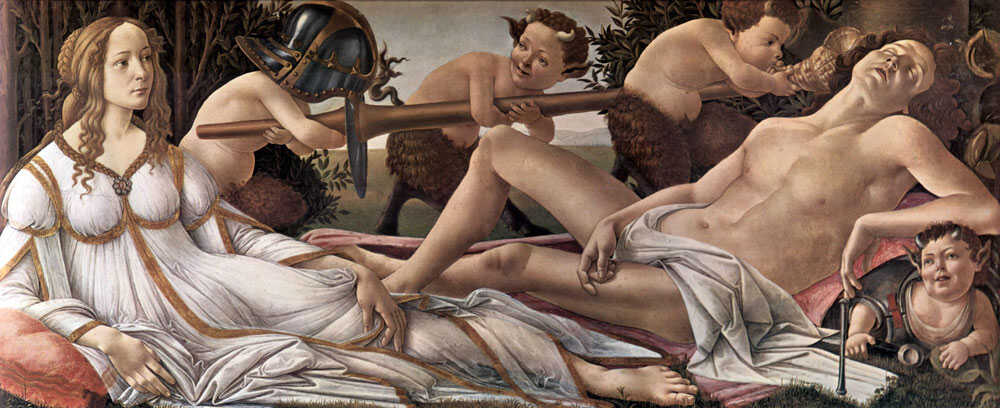
1. Sandro Botticelli, Venus and Mars
Botticelli was the greatest painter of the early Renaissance period in Florence. His art represents the pinnacle of the golden age of Florence’s Medici dynasty.
Botticelli’s work was groundbreaking — pure visual poetry and elegance. He was the first artist to break from tradition and depict large scale, non-religious mythological themes.
READ: Guide To The Botticelli Trail In Florence
Venus and Mars depicts the titular deities lounging in a meadow. Venus looks forward while Mars sleeps. He’s oblivious to wasps buzzing about his head or the mischievous satyr.
Some historians believe that the figures purportedly representing Mars and Venus are actually portraits of real lovers, contemporaries of Botticelli himself. They may have been Simonetta Vespucci and Giuliano de’ Medici. Some historians believe they represent Adam and Eve.
The National Gallery has another painting by Botticelli, Mystic Nativity. This was painted after he most likely fell under the influence of Savonarola and painted only religious subjects.
READ: Nutshell History of Florence
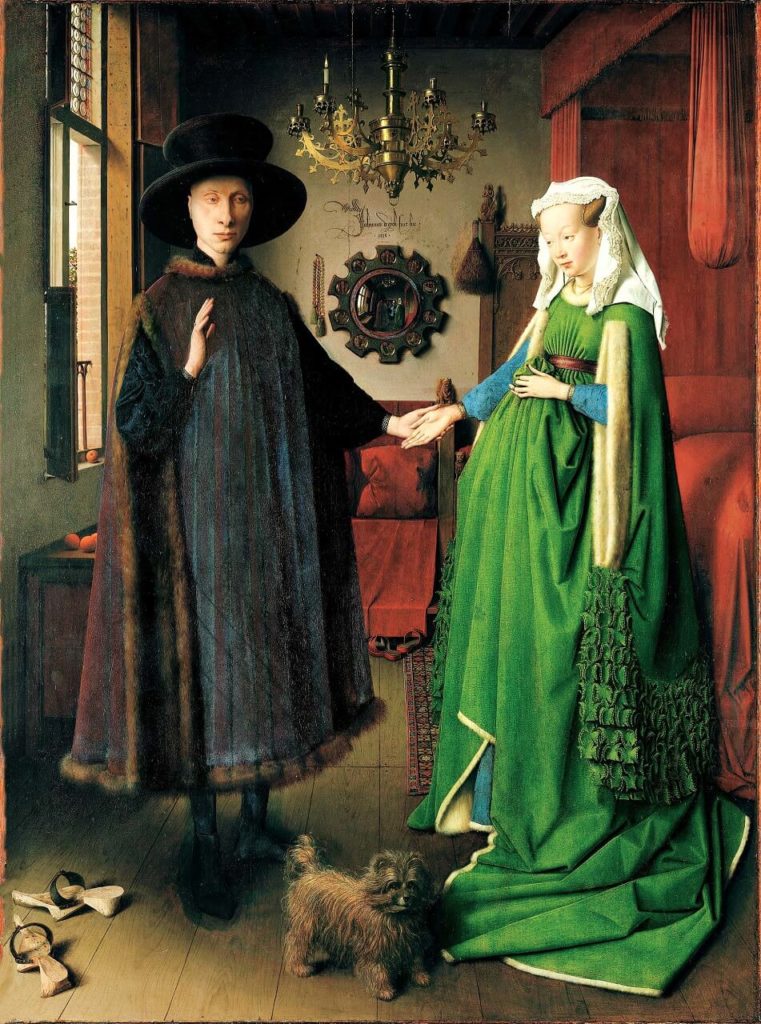
2. Jan van Eyck, The Arnolfini Portrait
Contrary to popular belief, the Renaissance didn’t just happen in Florence. It was happening simultaneously in Northern Europe. This National Gallery masterpiece may be the world’s first oil, rather than tempera, painting.
The Arnolfini Portrait is a stunning full length double portrait with astonishing realism. Presumably, it’s a portrait of a wealthy merchant and his wife in their upscale apartment in Bruges. But historians aren’t even sure who the sitters were.
Some think it’s a wedding scene. Others think it was a portrait intended to show off the family’s wealth. It may be the first entry in the genre of interior paintings of everyday life.
In the center back, a mirror glistens, proving a tour de force of perspective. Reflected in the glass are miniaturized versions of the couple. The room itself has a sophisticated orthogonal perspective. Van Eyck’s vivid color palette is on display.
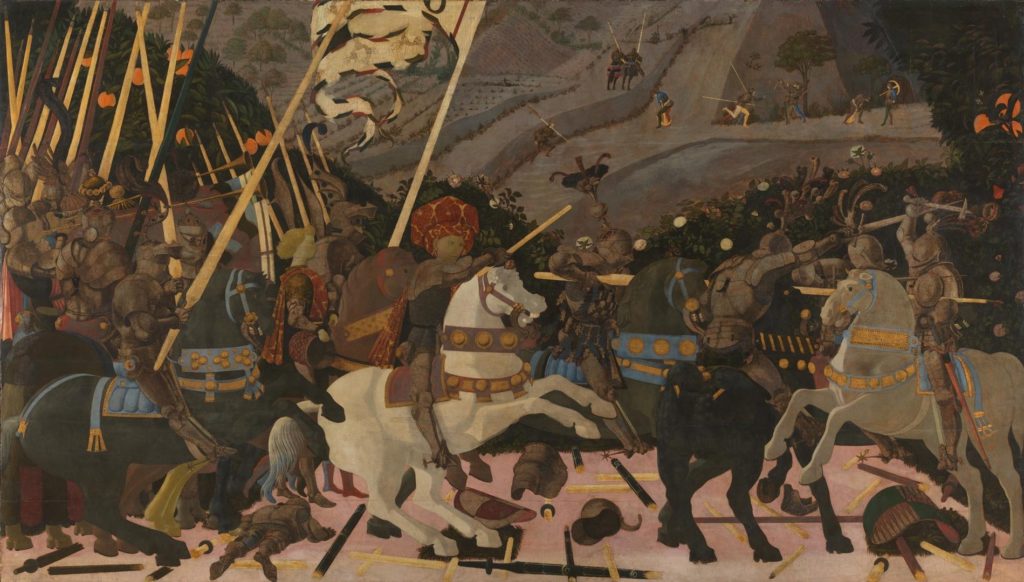
3. Paolo Uccello, Battle of San Romano
A student of the Italian sculptor Ghiberti (of Gates of Paradise fame), Uccello was a product of the International Gothic style. But he became an innovative artist of the early Renaissance.
Uccello became obsessed with the study of perspective. According to Giorgio Vasari, he neglected his family, becoming “solitary, eccentric, melancholy, and impoverished.”
Battle of San Romano is a painting on wood panel about Florence’s victory over Sienna. It’s one of a set of three. The other two are in Florence’s Uffizi Gallery and Paris’ Louvre. They were once all together in the Medici Palace.
In this crowded painting, Uccello shows scenes from the battle. It looks rather like a fake medieval tournament. Or perhaps a festive event. The ideas of surface decoration (Gothic) and deep space with a linear perspective (Renaissance) come together.
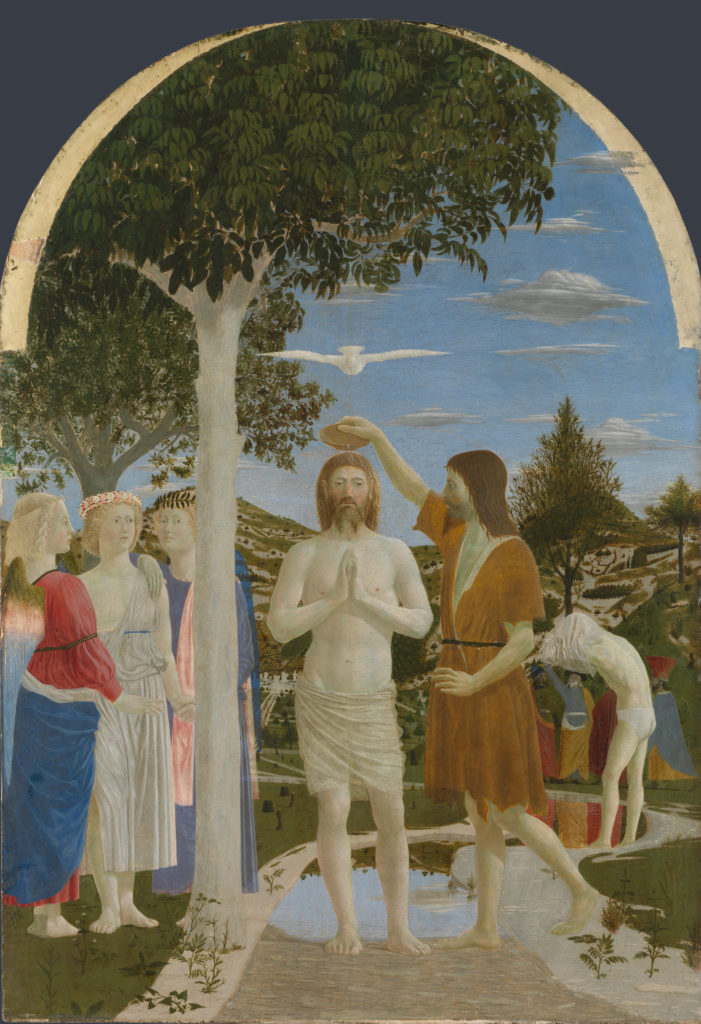
4. Piero della Francesca, The Baptism of Christ
Piero is a genius and foundational artist of the Quattrocento or early Renaissance. In his time, he was revered as a monarch.
Piero’s was a passionate student of math and geometry, possibly anticipating Leonardo da Vinci. His works are highly realistic, linear, and calculated.
They’re characterized by an infused calm and geometric sobriety. His cool tones and unmoving figures created a dream-like sense of timeless stillness.
This National Gallery masterpiece shows a key event in the life of St. John. Jesus is in the center, with a dove representing the Holy Spirit above him.
One significant feature is that you can see the landscape reflected in the river bed, which might be a Renaissance first.
READ: Guide To the Piero della Francesco Trail In Italy
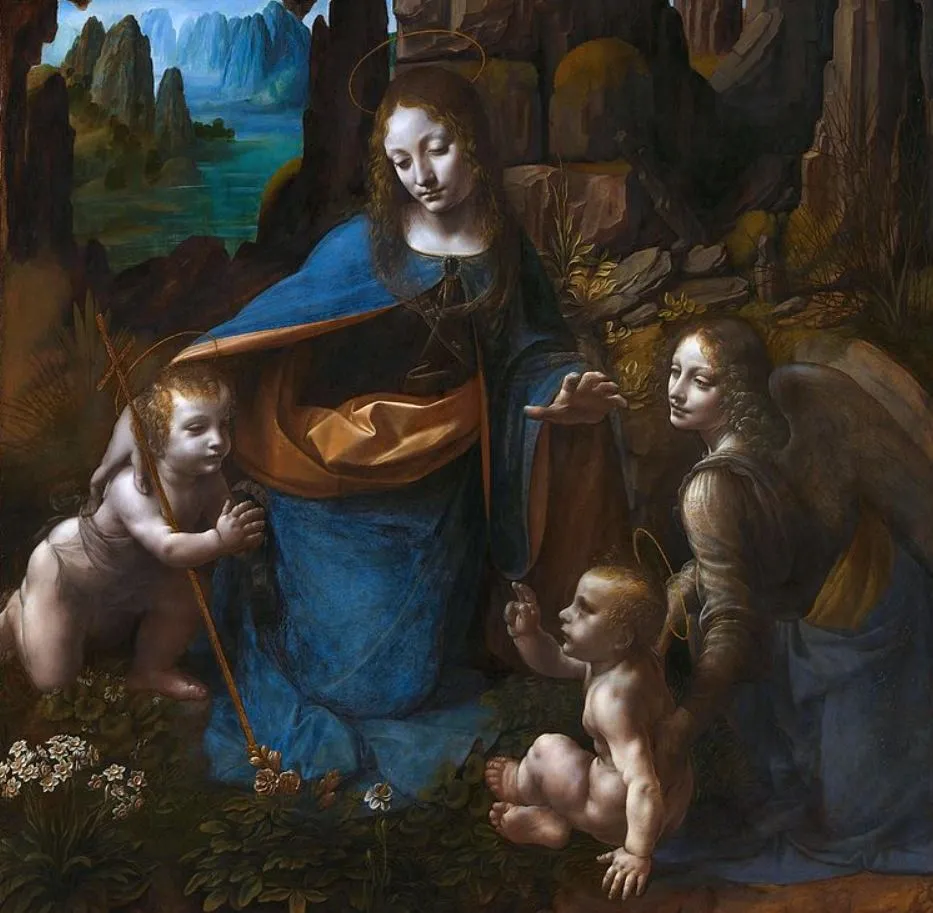
5. Leonardo da Vinci, Virgin of the Rocks
Virgin of the Rocks is the most famous painting at the National Gallery. There are two versions of this Leonardo painting, both commissioned during his time in Milan. Both paintings began to define the style of the High Renaissance. The earlier one is in the Louvre.
Leonardo’s painting depicts the legend of St. John the Baptist meeting the holy family as they flee to Egypt to escape Herod’s Massacre of the Innocents. The painting has an elaborate and mystical landscape, with bizarre rock formations.
The figures are grouped in a pyramid to give the illusion of space.With a supernatural glow to her face, Mary is kneeling rather than being enthroned as the queen of heaven.
For the first time in Renaissance history, the figures are missing halos and other indicia of the divine. This artistic departure made them seem more human and relatable to viewers.
READ: Guide To All Of Leonardo da Vinci’s Paintings
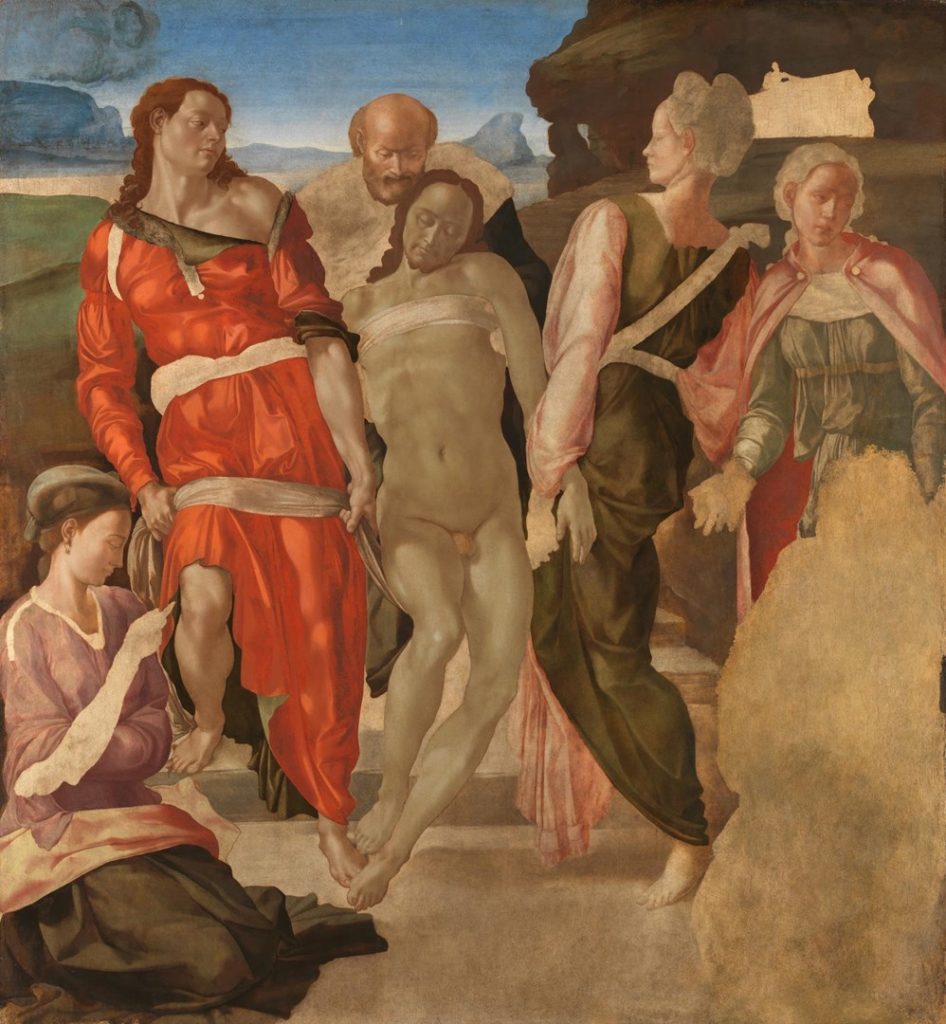
6. Michelangelo, Entombment, 1500-01
Michelangelo has been famous for over 500 years. He was a giant of the Renaissance, showing virtuosity in every medium — sculpture, painting, poetry, and architecture. Dubbed the “divine artist,” Michelangelo was the first sculptor to be hailed as a genius in his lifetime, as early as his 20s.
Michelangelo created some of the world’s most beautiful and revolutionary art. He was a master at creating idealized, technically perfect visions of the human body. Psychological and physical realism had never been portrayed with such panache.
The Entombment is one of only two known panel paintings by Michelangelo. The other, the Doni Tondo, is in the Uffizi Gallery in Florence.
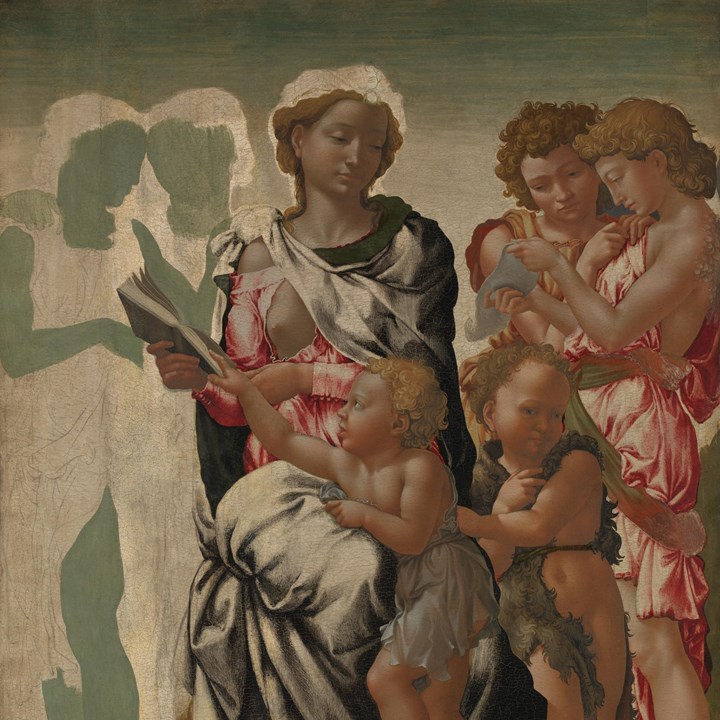
This painting was likely intended for for a finery chapel in the Church of Sant’Agostino in Rome. When Michelangelo left for Florence in 1501, he left it unfinished.
The painting is almost a high relief sculpture transposed onto canvas. It’s a complicated arrangements of figures. It shows Christ’s lifeless body being carried up some steps to his tomb.
There’s another very unfinished devotional piece by a young Michelangelo in the National Gallery, The Mancheter Madonna, from 1497.
READ: Michelangelo Frescos In The Sistine Chapel
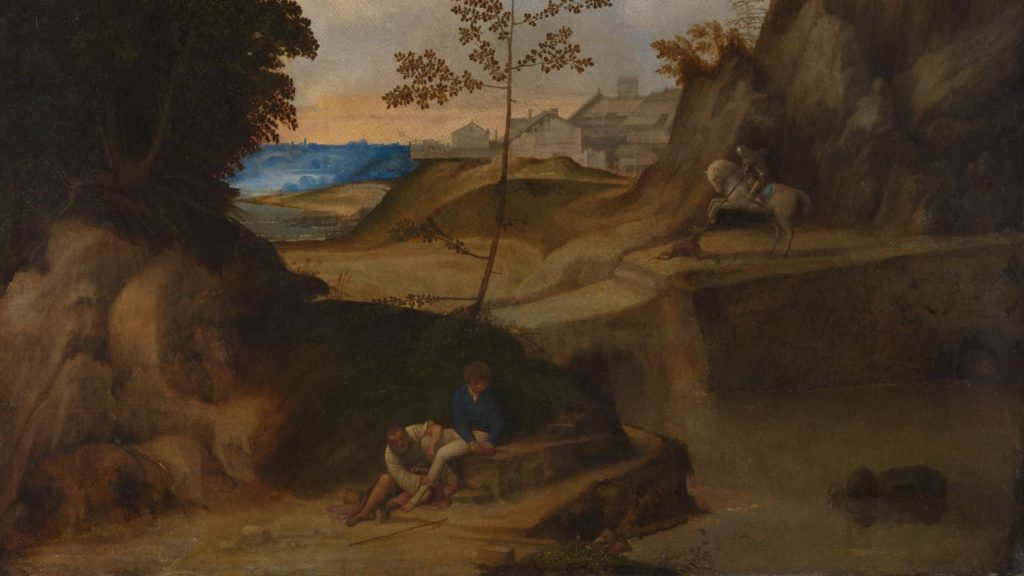
7. Giorgione, The Sunset
Giorgionewas an enigmatic Venetian Renaissance painter. He is universally known as one of the most influential of Western artists.
READ: Nutshell History of Venice
Giorgione had a short 15 year career, dying prematurely at just 37. He was likely the pupil of Giovani Bellini. Giorgione is known for his superhuman painting skills.
Giorgione is considered to have painted the first pure landscape paintings in art history. The Sunset is a poetic moody painting, a trait that is called “Giorgionesque.”
Although the somber landscape seem artificial, it invites us to enter it and imagine it. There are soft gradation of light and shadow and mysterious barely visible figures.
8. Raphael, Pope Julius II
Raphael was one of the “holy trinity” of Renaissance painters, along with Leonardo da Vinci and Michelangelo. Nicknamed the “Prince of Painters,” Raphael’s compositions were serene and harmonious.
He mastered the signature techniques of the High Renaissance — sfumato, perspective, anatomical correctness, and authentic emotionality and expression. To that, he added vivid color and clarity.
Pope Julius II gave Raphael his first big career break in 1507 when he was commissioned to paint the Raphael Rooms in the Vatican Museums. In 1512, he painted an intimate portrait of the great pope and art patron after his death.
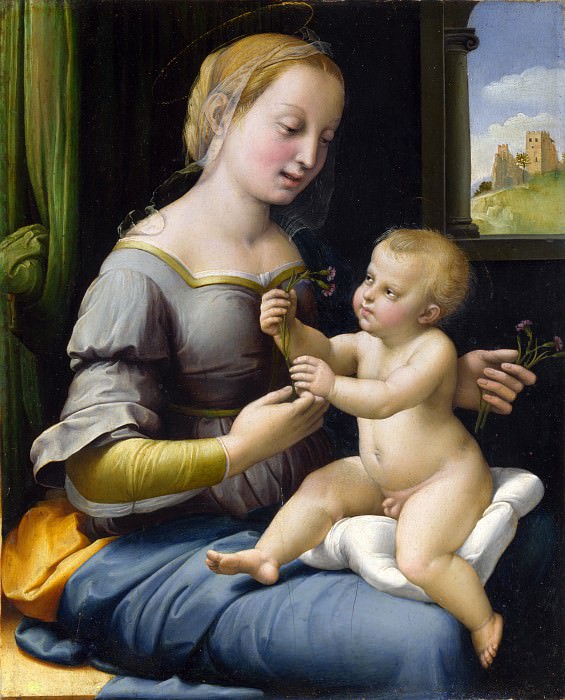
The portrait initially hung in the Church of Santa Maria del Popolo in Rome. When art historian and painter Giorgio Vasari saw it, he exclaimed “it was so lifelike and true it frightened everybody who saw it, as if it were the living man himself.”
The pope is portrayed in 3/4 profile to the right, seated in an armchair. He’s melancholy and lost in through. It was unusual at the time to paint a pope in a particular mood. Julius was depressed because the city of Bologna had seceded from the papal states.
Raphael’s use of oil paint is almost unequalled in history. Look at the wrinkling of the skin as his left hand grips the throne, the flow of white fabric over his knees, and the sense of his wiry body inside his robes.
READ: Guide To Raphael’s Famous Paintings
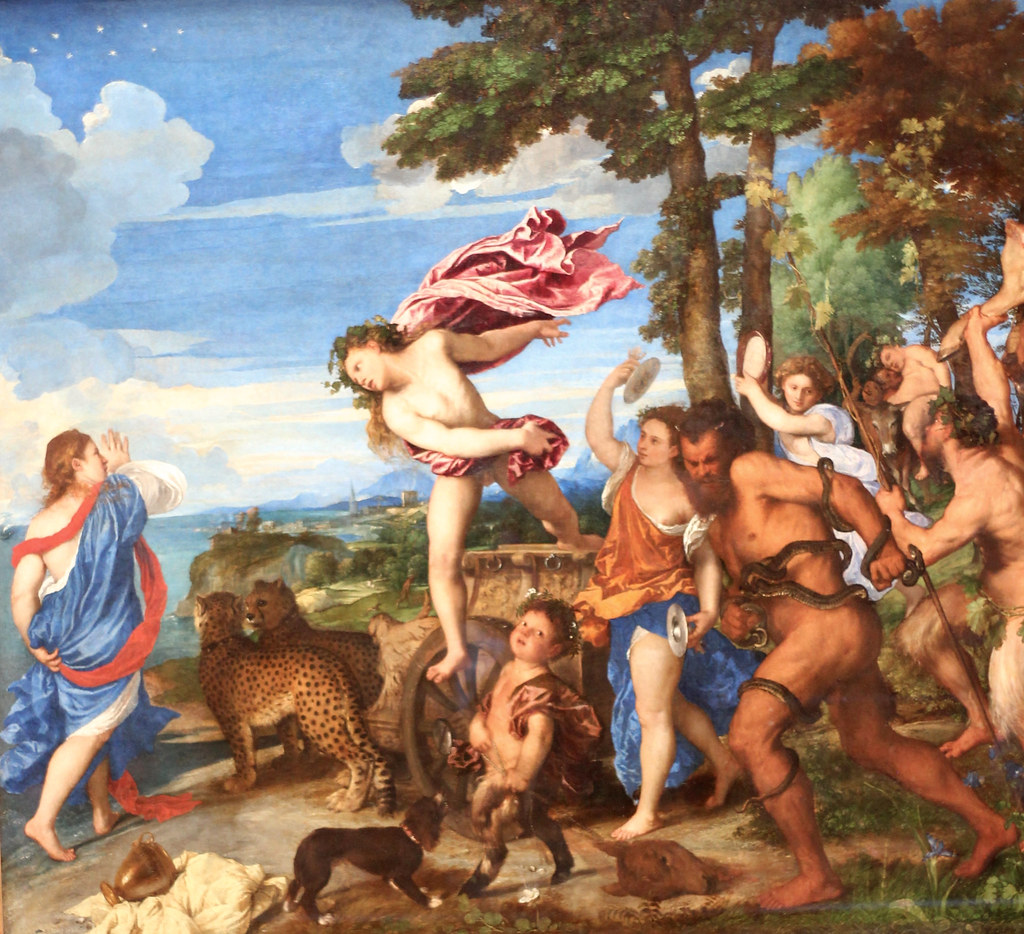
9. Titian, Bacchus and Ariadne
Titian is widely considered the most important and successful painter of the 16th century Venetian school. Titian was the master of oil, a prolific producer of colorful paintings.
Bacchus and Ariadne was commissioned by Alfonso d’Este. The story of Bacchus and Ariadne hadn’t really been portrayed before.
The story goes that Ariadne helped Theseus vanquish the Minotaur. But she is thanklessly abandoned by him on the island of Naxos.
In this calamitous painting, Bacchus’ chariot is pulled by cheetahs. He has a rowdy retinue. Seized by a god, Ariadne would become the constellation show in the top left.
READ: Guide To Venice’s Accademia Gallery
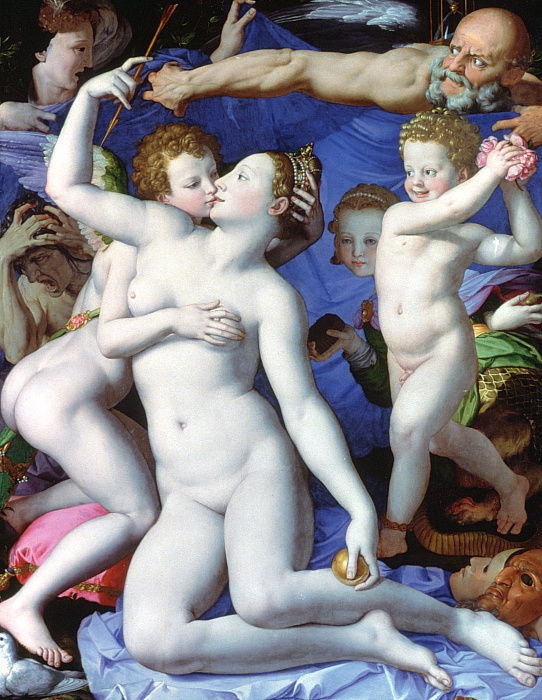
10. Bronzino, An Allegory With Venus and Cupid
Bronzino was a Mannerist painter. He worked in the Medici court and was the prize pupil of Pontormo. Bronzino became famous as a portraitist of the Medici duke and duchess.
READ: History of the Medici
This racy painting has long fascinated art historians. It’s likely the most frankly erotic painting in the collection. It almost appears like a glossy fashion magazine.
As a painting for the court, the painting likely intentionally incorporated a puzzle and emblematic mythological figures. Unraveling the symbolism was half the fun.
The painting is a scene of unchaste love, set against an intense ultramarine blue. The figures are cold as enamel.
The goddess of love is identified by an apple and holds Cupid’s arrow. A laughing child throws petals at the pair. Amidst them are the figures of deceit, Father Time, Jealously, and Oblivion, who testify to the bad results that come from lust.
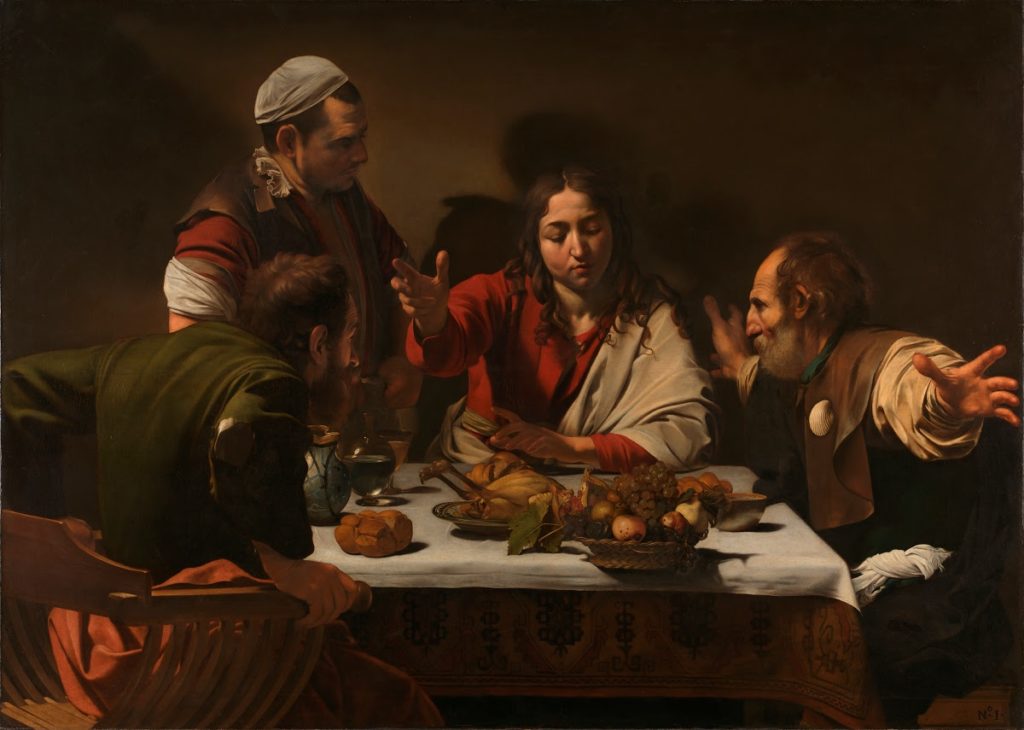
11. Caravaggio, The Supper at Emmaus
Caravaggio painted two versions of Supper at Emmaus. One is in the National Gallery and the other is in the Brera Museum in Milan Italy. It’s believed Caravaggio painted this work when he was a fugitive from justice in Rome, wanted for murder.
READ: Guide To The Caravaggio Trail in Rome
Caravaggio was the greatest painter of the Baroque. He was extremely photo realistic in his rendering of his subjects. Caravaggio took the dramatic light-dark contrast called tenebrism to the extreme. He also exalted the mundane and vulgar elements of real life.
In this painting, Caravaggio depicts a common theme — Jesus’ first supper after his resurrection and the discovery of his empty tomb. Two disciples recognize him and are shocked.
It’s a simple painting, without much narrative, though the gestures are theatrical. And the light and shadow create an intense atmosphere.
Two interesting facts. Some art historians say that Jesus is a self portrait of Caravaggio.
In addition, not everyone accepts this painting as an authentic Caravaggio. There are plenty of Caravaggio forgeries. In this one, the faces may not be the quality of undisputed Caravaggio’s.
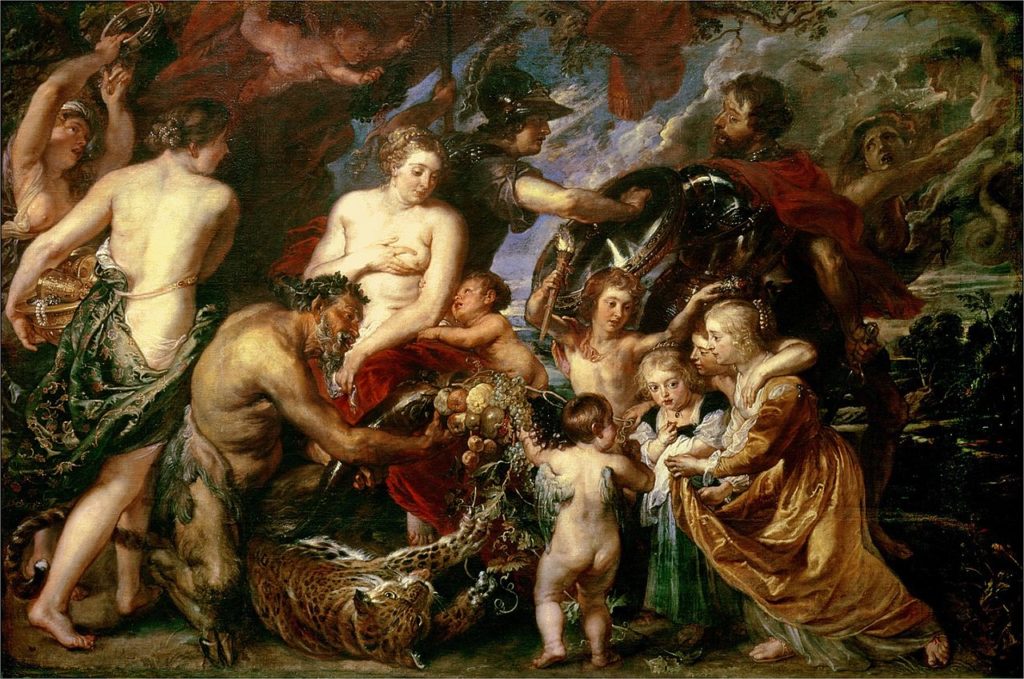
12. Peter Paul Rubens, Peace and War
Rubens was one of the greatest painters of the 17th century. He’s renowned for his exuberant Baroque style.
He painted it all — curvaceous nudes, religious scenes, landscapes, portraits, and allegories. His paintings were an intriguing blend of wit and seriousness, of erudition and exuberance.
Rubens painted this work as a gift for King Charles I, during Ruben’s diplomatic mission in England. Rubens was a pacifist in a world of war mongers and martial enthusiasts.
Rubens used ancient Greek and Roman mythological subjects. A naked woman, symbolizing peace, feeds the god of wealth. The goddess of wisdom, Minerva, chases away the god of war, Mars. There are symbols of the wealth associated with peace — the children, the cornucopia, olive crown, etc.
Rubens message is clear: rejecting war and embracing peace will bring prosperity.
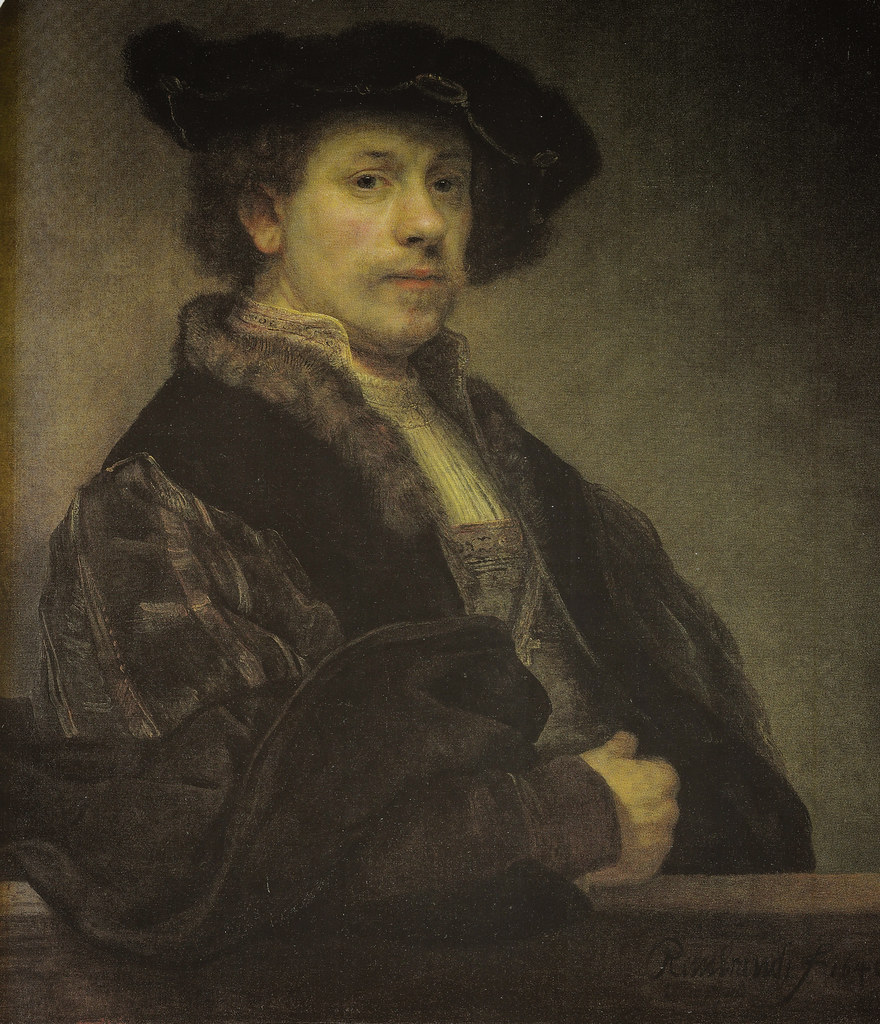
13. Rembrandt, Self Portrait at the Age of 34
Rembrandt seemed to have a sub specialty in self portraits. He made over 80 of them in his lifetime, exploring his own face and personality in endless ways.
In this meticulously painted portrait, Rembrandt depicts himself as a wealthy man and successful painter. He’s dressed up in a Renaissance costume. There’s also a poetic quality to him.
The portrait and likeness was inspired by Raphael’s painting of Baldassarre Castiglioni, which is in the Louvre. But its bright colors, luxurious fabrics, and direct gaze are more indebted to Titian.
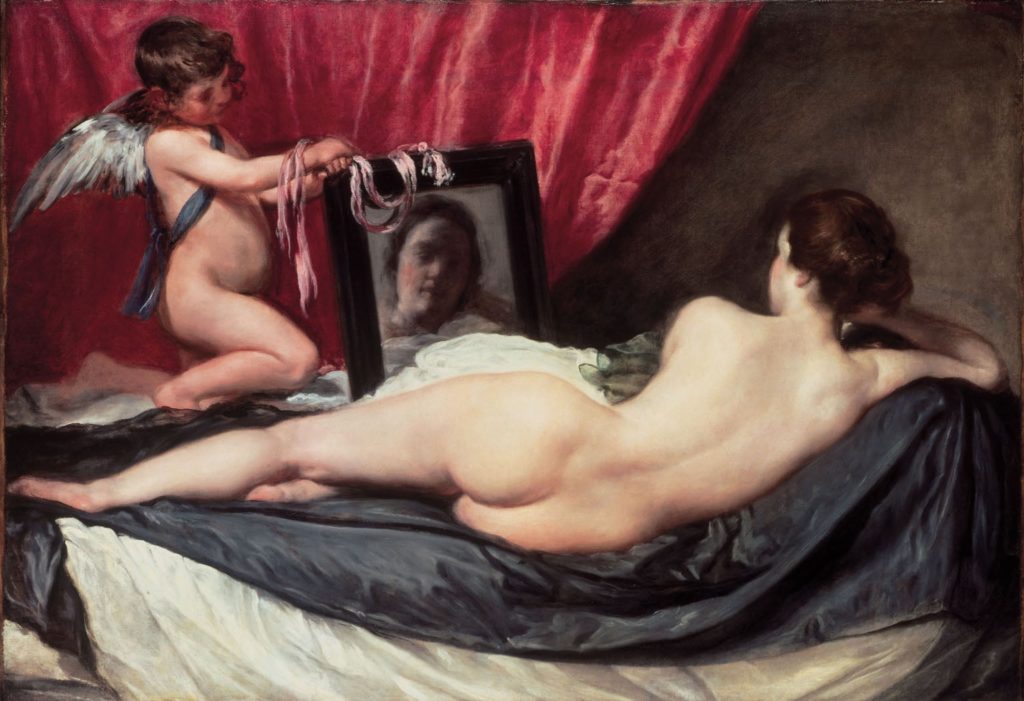
14. Velazquez, The Toilet of Venus
Velazquez was the greatest painter of 17th century Spain. The Toilet of Venus is also known as the Rokeby Venus because of the hall it hung in.
It’s an enigmatic must see painting in the National Gallery. Art historians don’t even know who commissioned the piece. It’s Velazquez’s only surviving nude and the most famous one in England.
The Rokeby Venus was one of the most erotically charged images of its era. In the period of Spanish Inquisition, it was bold to paint nudes. Velázquez only got away with it because he was an esteemed court painter.
An unknown model reclines on a bed with her back to viewer. We only know she’s Venus because of the presence of a winged Cupid.
The woman is not your typical Italian style nude. She’s slender and has modern hair style. Her curvy hip is set off by the white fabric in the center. It almost looks like she’s blushing.
The flirty quality is emphasized by Cupid’s mirror. It makes the viewers think she’s looking back at them, a trick known as the “Venus effect.” Her face in the mirror seems older than her body, a reference to the inevitable passing of time.
100 years ago, the Rokeby Venus was attacked by a suffragette. She gave it five slashes with a meat chopper. But the painting was restored.
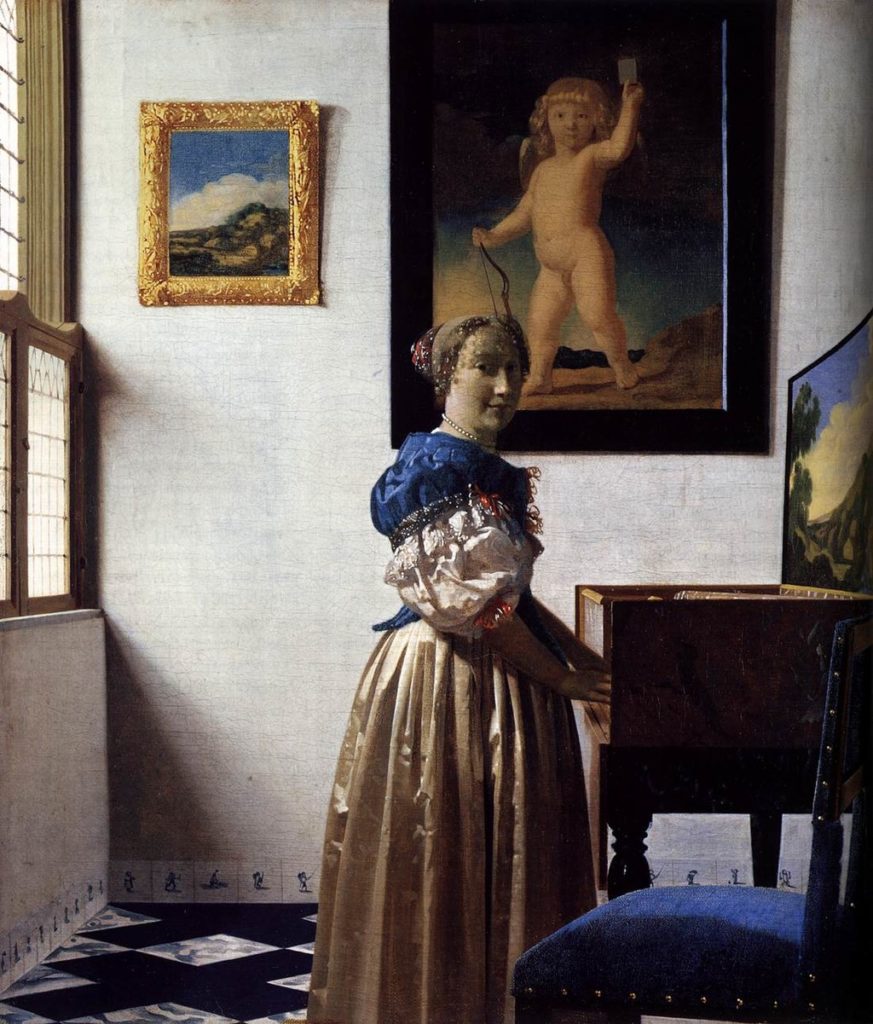
15. Johannes Vermeer, Young Woman Standing at a Virginal
Vermeer was one of the premiere painters of the Dutch Golden Age. He specialized in domestic interior scenes of middle class life. There are very few Vermeer paintings in the world.
This one demonstrates his trademark sense of rhythm and stability. As with all his painting, light permeates the scene, beautifully rendering his subjects using light and shadow.
In the painting, a graceful woman in a gold gown contemplates a virginal, which is a small harpsichord. She’s illuminated solely by daylight streaming in through the window, in an almost ethereal way.
Art historians think she is meant to be a young woman dreaming of love. The painting of Cupid and the empty chair suggest a lover is gone.
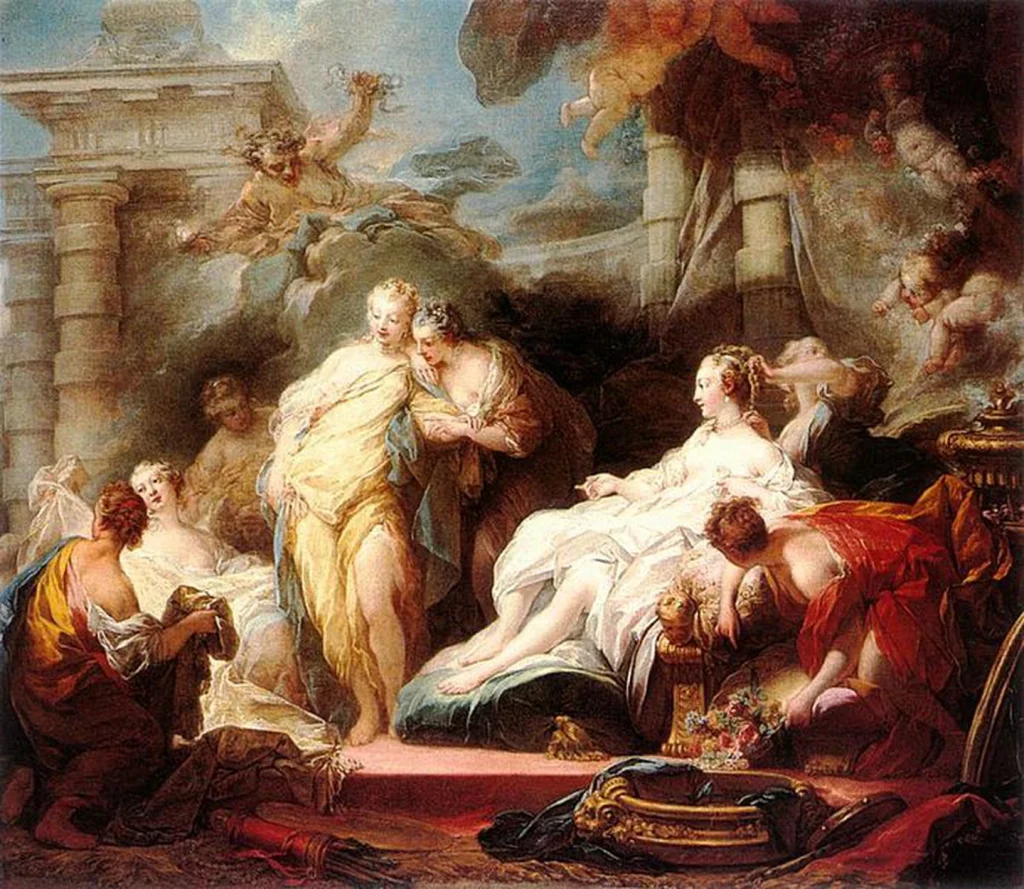
16. Jean-Honoré Fragonard, Psyche showing her Sisters her Gifts from Cupid
Fragonard was a painter of the high Rococo period. He was the prize winning pupil of Boucher, but with a broad range of color. Fragonard’s paintings are associated with exuberance and hedonism.
This painting tells an allegorical love story from Greek mythology. Cupid is smitten with Psyche the moment he sees her. He decides to marry her under the condition that she will never be allowed to see him.
This painting depicts the moment where Psyche, pampered and living in a palace, shows off the gifts she’s received from her mysterious husband. Her sisters are overcome by jealousy.
To wreck her happiness, the sisters trick the innocent girl into disobeying her husband’s wish. Jealousy and the mischief to come is represented by the emerging dark cloud suffusing the painting.
This painting served as a moral instruction to the French society ruled by monarchy, warning not to question authority.
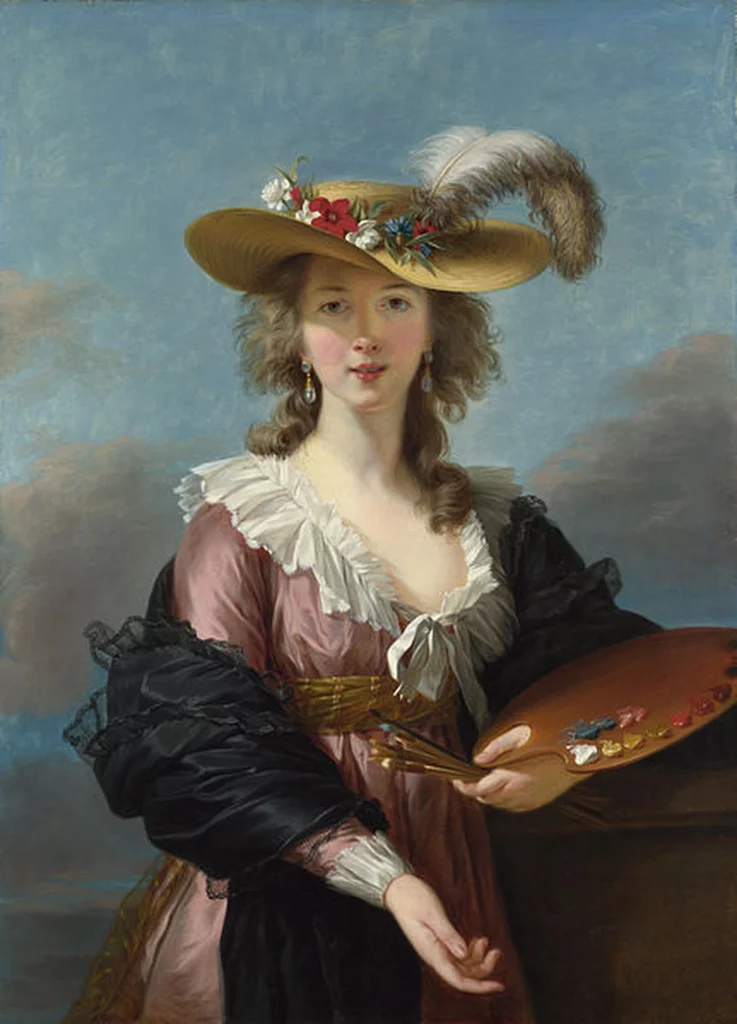
17. Elisabeth Louise Vigée Le Brun, Self Portrait in a Straw Hat
Vigee Le Brun was an 18th century French painter specializing in portraits, especially those of women and children. She was a revolutionary in her time, pioneering a new style of naturalism and dispensing with props.
Le Brun broke out of the confines of her gender and was an immensely successful artist. She won fame when she became the court painter for Marie Antoinette, the much maligned queen of France.
In this self portrait, Le Brun shows herself out in nature against a cloud flecked sky. She wears a hat with a dashing ostrich feather. Le Brun depicts herself as a self-confident professional with palette and brushes in hand
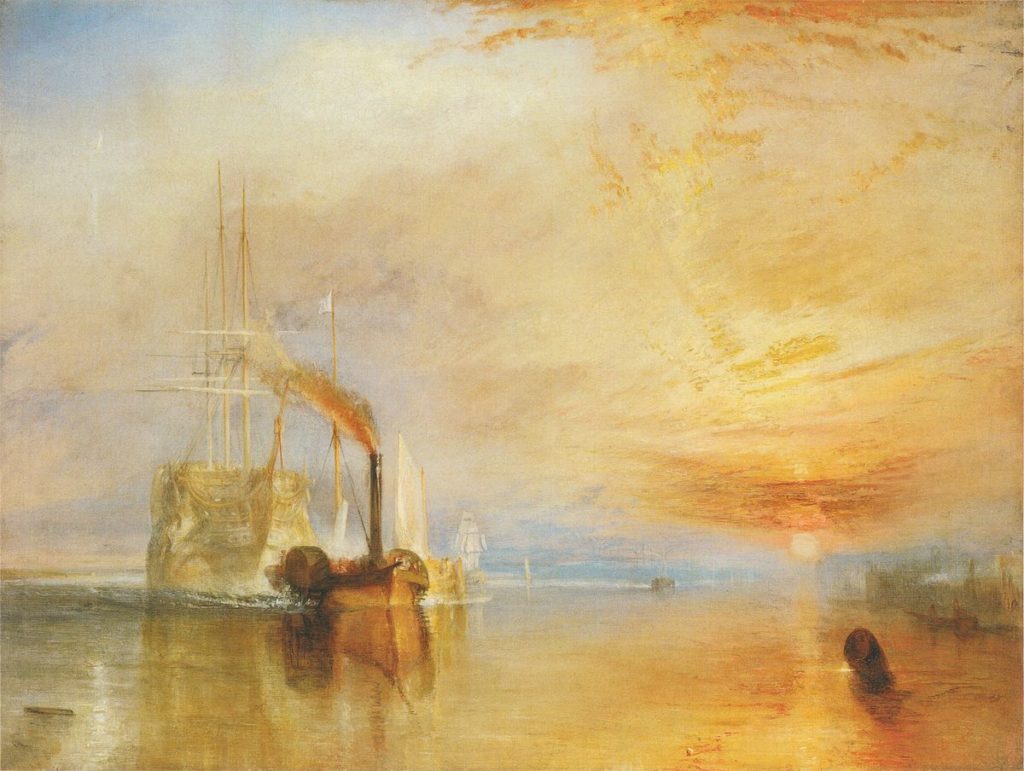
18. J.M.W. Turner, The Fighting Temeraire
Turner helped found Romanticism, a movement that set the stage for Impressionism. He used painterly effects to create a subjective scene.
The Fighting Temeraire is Turner is his prime. It’s one of the National Gallery’s most famous masterpieces.
Turner depicts the battleship Temeraire being towed away for scrap. It’s thought to symbolize the decline of Britain as a seafaring power.
The artist’s skill is evident in the expert way he layers and shades the tones of the sea and sky. The dying light showing behind the bulk of the ship only serves to make the scene appear more poignant.
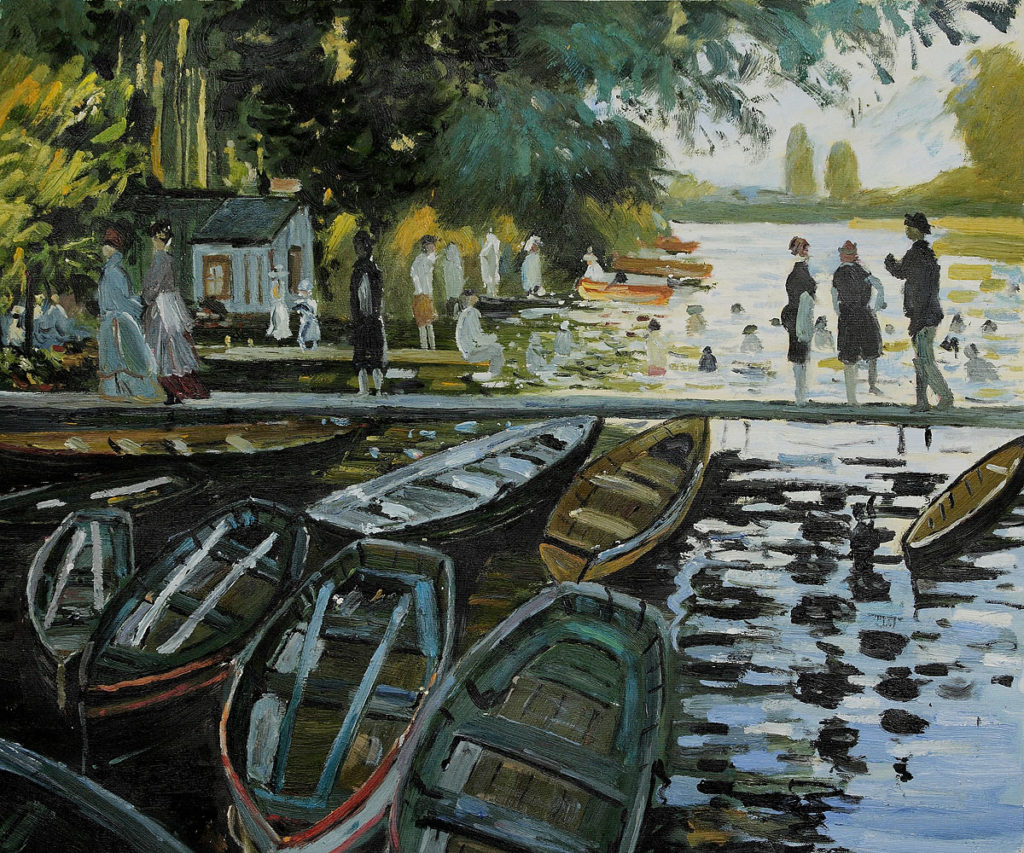
19. Claude Monet, Bathers at La Grenouillère
Claude Monet was the founder of Impressionism, a once controversial movement. The Impressionists aimed to capture the ephemeral, sensory effect of a leisurely scene — the impression — objects made on the eye in a fleeting instant.
The Impressionists used fast and loose brushwork, a lighter palette, and tried to capture the effects of light. They painted outside in “plein air” instead of inside.
Monet painted Bathers at La Grenouillere, an early painting, along side his cohort Renoir. With this painting, he embarked on experiments that prove dimportant for his mature works, like his water lilies at Paris’ Musee Marmottan Monet and Orangerie.
Painting tubes had just been invited, allowing artists to paint more easily outside. In this painting, you can see Monet using thickly dubbed clusters of paint. The human figues are bare patches of paint.
READ: Impressionism Itinerary For Paris
20. Vincent van Gogh, Vase with Fifteen Sunflowers
Van Gogh was a Dutch Post-Impressionist artist who spent most of his life in France. He only sold a few paintings in his lifetime. Van Gogh fit the stereotype of tortured artist.
Van Gogh’s landscapes and portraits were radical. They were like nothing anyone had painted before. His art works feature swirling lines, emotional honesty, and unexpected and exaggerated swatches of bold color.
Van Gogh wanted to be known as the painter of sunflowers. He started painting flower still lifes to experiment with color. When fellow artist Paul Gauguin came to live with him in Provence, Van Gogh decorated his room with his sunflower paintings.
The Sunflowers in the National Gallery is one of van Gogh’s most famous paintings. It’s the most important of the artist’s series of still lifes.
A young curator bought them from van Gogh’s sister in law, Jo Bonger. Sunflowers would become the National Gallery’s most loved painting. It’s said that the floor in front of the Sunflowers is more scuffed than that in front of any other National Gallery painting.
READ: Review Of Immersive Van Gogh
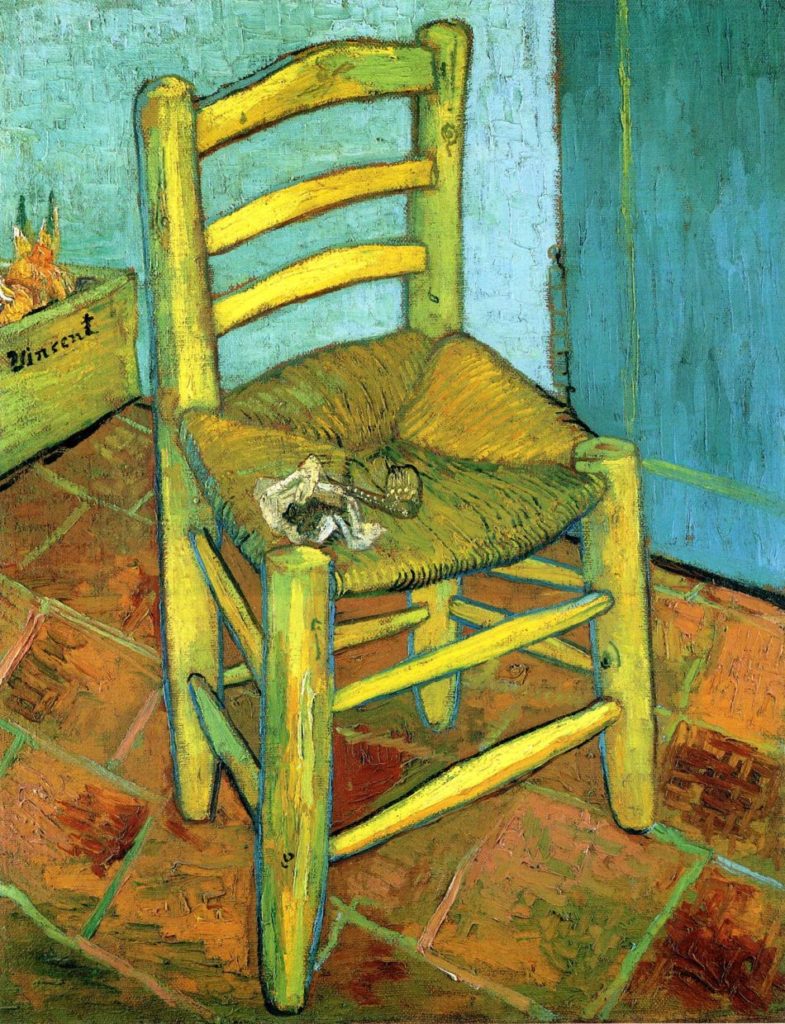
Practical Guide & Tips For Visiting the National Gallery of Art
Address: Trafalgar Square, London WC2N 5DN
Hours: Open daily 10 am to 6 pm and Friday until 9 pm
Entry: free, except for special exhibitions
Entrances facing Trafalgar Square: The Portico Entrance in the center (under the Dome), the Getty Entrance (to the right), and the Sainsbury Entrance (in the smaller building to the left of the main entrance).
When To Go:
The best time to visit the National Gallery is mid week or first thing in the morning. The late Friday opening is another relatively crowd free time. Rooms 45 and 46, with the Van Gogh and Impressionist paintings, are the most crowded spots in the museum.
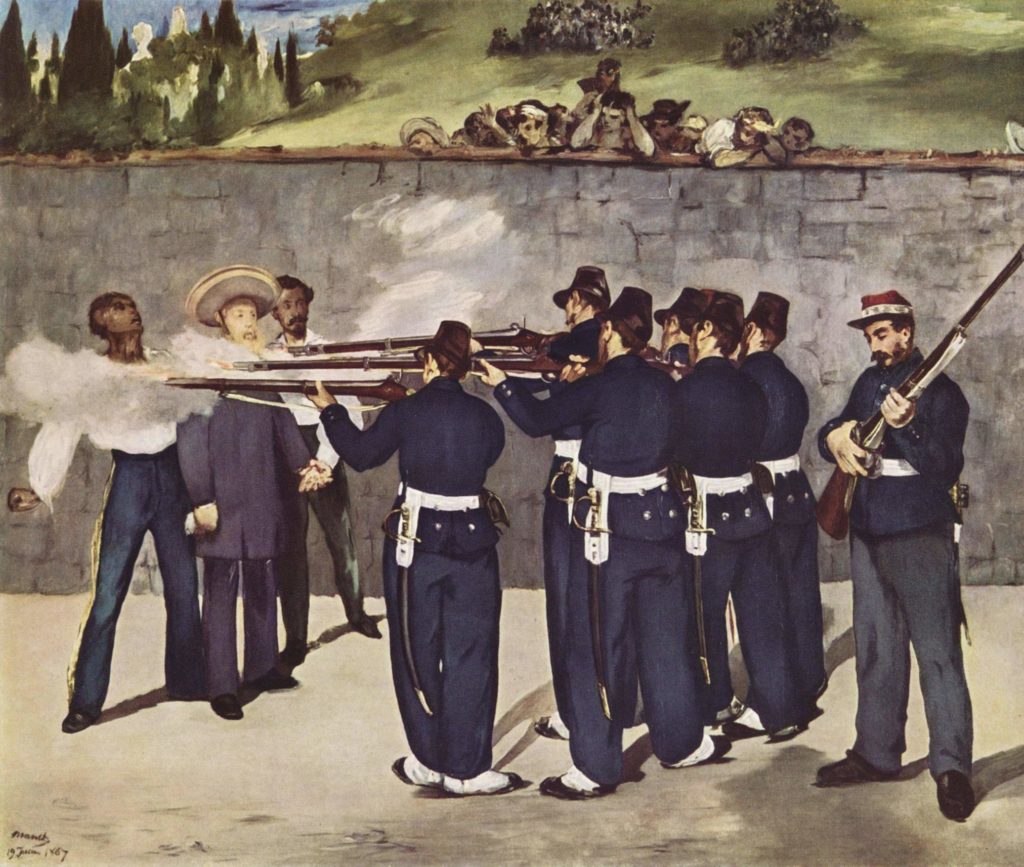
Food: You can get food and drink at the The Espresso Bar by Muriel’s. In spring 2022, the museum will open another café, Muriel’s Kitchen, and a new restaurant, Ochre.
I hope you’ve enjoyed my guide to the National Gallery of Art and its masterpieces. You may enjoy these other London travel guides and resources:
- 3 Days in London Itinerary
- 5 Days in London Itinerary
- Best Museums In London
- Hidden Gems in London
- Best Day Trips from London
- Guide To the Churchill War Rooms
- Tourist Traps To Avoid in London
- Guide To the Tower of London
- Guide To Hampton Court Palace
- Guide To Hatfield House
- Guide To The Henry VII Chapel
If you’d like to visit the National Gallery in London, pin it for later.

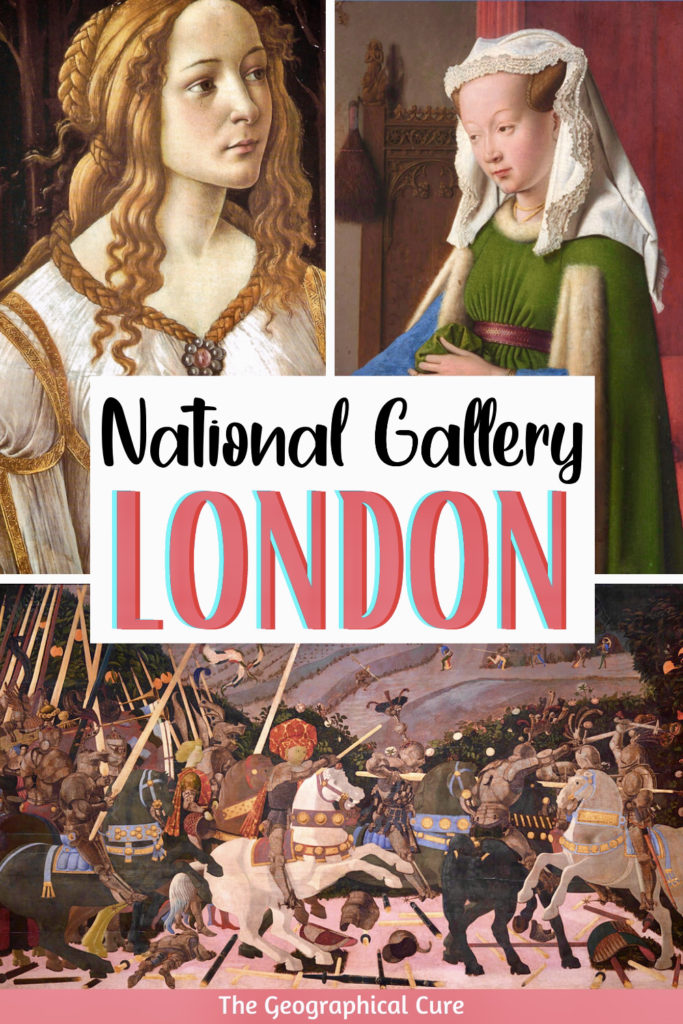
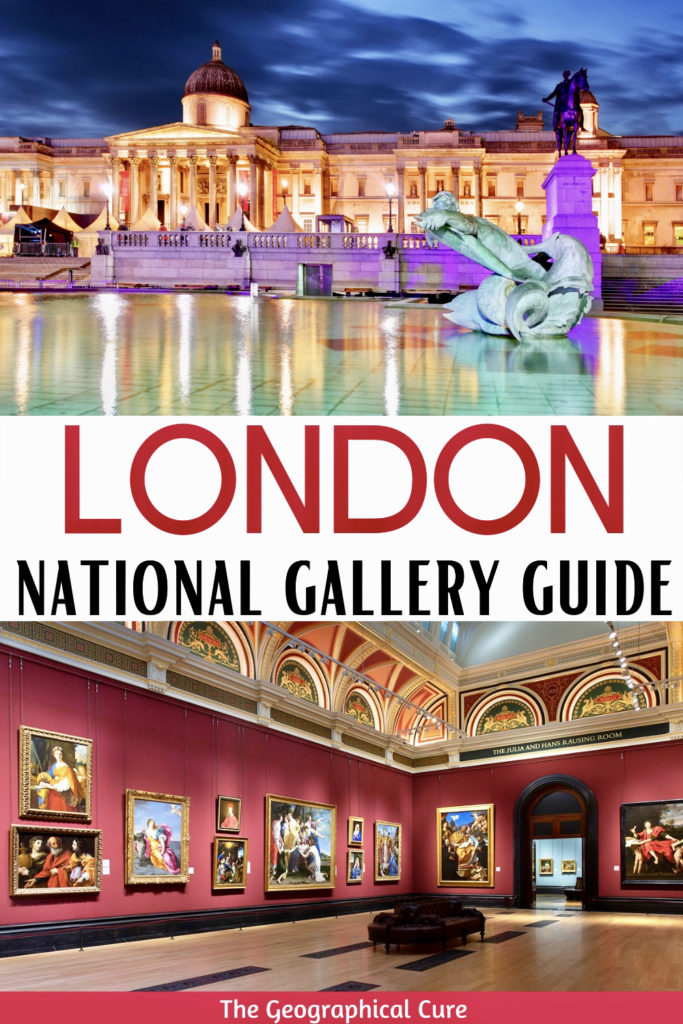
Wonderful, excellent, exciting: I look forward to my visit tomorrow but I wish I could spend a week rather than a day.
It’s really a fantastic museum. Enjoy!
Bronzino’s “Allegory with Venus and Cupid” is the subject of my historical novel “Cupid and the Silent Goddess”, which imagines how the painting might have been created in Florence in 1544.
See: https://www.pagedor.co.uk/books/p/cupid-and-the-silent-goddess-alan-fisk
Sounds like that would be great reading!